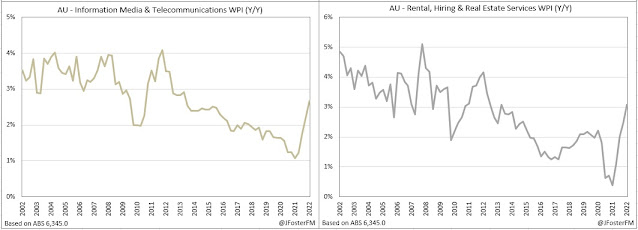Australian wages growth disappointed to the downside of expectations in the March quarter rising by 0.7% to 2.4% Y/Y. Weighing on the outcome was a reduction in the share of private sector jobs receiving wage rises from an elevated level in the December quarter. However, for the jobs that did receive a rise, the average wage increase lifted to its fastest in nearly 9 years. A tightening labour market should gradually generate faster wages growth.
- The headline WPI (total hourly rates of pay ex-bonuses) fell short of expectations printing at 0.7%q/q (vs 0.8%), with the annual pace firming from 2.3% to 2.4% (vs 2.5%).
- Private sector WPI increased by 0.7% in the quarter, matching the rise seen in the previous quarter. Annual growth remained at 2.4%.
- Public sector WPI lifted by 0.6%q/q, slightly lower than in Q4 (0.7%), firming the annual pace from 2.1% to 2.2%.
Wage Price Index — Q1 | The details
Wages growth in the private sector was unchanged from the increases recorded in the prior quarter at 0.7%q/q and 2.4%Y/Y. In the release, the ABS found that the share of jobs receiving wage reviews was in line with the historical pattern for this time of year, though in the prior quarter there had been an unusually high share of jobs that received wage increases. This likely explains why private sector wages did not show a faster rise. This is particularly so given that the ABS also reported that of the jobs that did receive wage rises, the average increase (3.4%) had lifted to its fastest since Q2 2013.
Public sector wages growth firmed slightly by 0.6%q/q to 2.2%Y/Y. This is slower than in the private sector due to long-standing measures in the sector to contain the pace of wages growth.
By broad industry sector, wages growth is running fastest in business services (2.6%Y/Y). Job mobility in these industries has lifted sharply over the Covid period as many people have left their jobs to take up other opportunities that have come about amid the economic recovery. This has led to increased competition for workers, putting upward pressure on wages.
Wages growth in the goods-related sector lifted slightly to 2.4%Y/Y. At the industry level there is significant variation in outcomes. Wages growth is above its pre-pandemic pace in industries that have run up against capacity constraints, including in construction, manufacturing, retail trade and wholesale trade. However, the recovery has lagged in the transport and utilities industries.
The household service sector saw wages growth boosted by reopenings from the Delta lockdowns during the December quarter. This momentum faded in the March quarter, with wages growth easing in the healthcare and hospitality industries. The recovery continued in the arts and recreation industry, which is now back at its pre-pandemic pace of wages growth.
Wage Price Index — Q1 | Insights
On the back of today's softer-than-expected outcome, some of the pricing for a 40bps rate hike from the RBA in June has been taken back. Tomorrow's labour market report will be closely watched. Historical relationships suggest that wages growth should be heading higher given the tightness in the labour market (2022 dot is circled), and that also fits with surveys, including the RBA's business liaison, that consistently report rising wage pressures.













